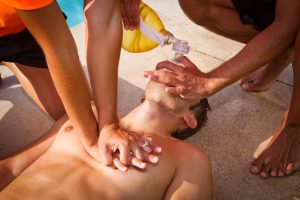Emergency oxygen is the proper first aid for treating a dive injury, but not all methods of oxygen delivery are appropriate in all situations. A demand valve is an easy-to-use system that can deliver a high concentration of oxygen while making your resources last as long as possible — something that’s critical when help is more than a few minutes away. When an injured diver is relatively stable and can breathe on their own but evacuation could take hours or days, a demand valve is an invaluable tool. When was the last time you evaluated your oxygen administration protocols?
 Why Oxygen?
Why Oxygen?
Dive accident victims benefit from oxygen administration in two ways. First, breathing high concentrations of oxygen can speed the elimination, or washout, of inert gas from the body. Second, areas of the body with reduced oxygen supplies due to compromised blood flow may receive enough oxygen to minimize or prevent tissue injury. Increasing the oxygen content of the gas an injured diver breathes, whether by providing pure oxygen or, in situations where oxygen is not available, providing nitrox, can help improve the outcomes of several types of serious injuries, including decompression illness (DCI).
Demand Valves
Demand valves function similarly to second-stage scuba regulators. With a well-sealed mask, a demand valve can deliver about 95 percent oxygen whenever the patient inhales. The devices are designed for conscious and alert patients whose respirations are strong enough to trigger the flow of oxygen. Demand valves are sometimes mistaken for manually triggered ventilators, which are used to administer positive-pressure ventilations for people who are not breathing on their own, so it’s important to regularly practice with the equipment you’ll have to use in an emergency. Knowing exactly what equipment you have at your disposal and how to use it will improve your ability to effectively respond to an emergency when the time comes.
 The benefits of a demand valve are its ability to deliver high concentrations of oxygen while also conserving the supply of emergency oxygen as much as possible. Research shows that divers should be given the greatest concentration of oxygen possible (until the supply runs out) while en route to qualified care. This means that if available, pure oxygen should be delivered until all sources are depleted even if that means delivery stops before the diver reaches qualified care. The use of a demand valve regulator prevents the loss of oxygen that takes place with constant-flow oxygen delivery devices (such as nonrebreather masks and nasal cannulas) by delivering oxygen only when the injured person inhales. With a good mask seal the delivered gas could have an oxygen concentration of up to 95 percent, making it one of the most effective delivery systems.
The benefits of a demand valve are its ability to deliver high concentrations of oxygen while also conserving the supply of emergency oxygen as much as possible. Research shows that divers should be given the greatest concentration of oxygen possible (until the supply runs out) while en route to qualified care. This means that if available, pure oxygen should be delivered until all sources are depleted even if that means delivery stops before the diver reaches qualified care. The use of a demand valve regulator prevents the loss of oxygen that takes place with constant-flow oxygen delivery devices (such as nonrebreather masks and nasal cannulas) by delivering oxygen only when the injured person inhales. With a good mask seal the delivered gas could have an oxygen concentration of up to 95 percent, making it one of the most effective delivery systems.
Note that if a diver cannot trigger the demand valve on their own or a good mask seal cannot be achieved it may be necessary to opt for another method of oxygen delivery. A nonrebreather mask is one option that provides a constant high flow of oxygen and does not require activation for oxygen delivery. A nasal cannula is a similar option that provides oxygen via two small prongs inserted into the nostrils, but the inspired oxygen from nasal cannula delivery is significantly less than that of other methods and should be considered a second-choice option. For more serious injuries involving divers who cannot breathe for themselves, bag-valve masks and manually triggered ventilators allow rescuers to provide oxygen as well as ventilation.
 While the gas conservation and high oxygen content delivery make demand valves nearly ideal in many situations, it’s important to keep the range of oxygen delivery methods on hand. For more information on evaluating injured divers and determining the best response protocol, visit DAN.org.
While the gas conservation and high oxygen content delivery make demand valves nearly ideal in many situations, it’s important to keep the range of oxygen delivery methods on hand. For more information on evaluating injured divers and determining the best response protocol, visit DAN.org.


